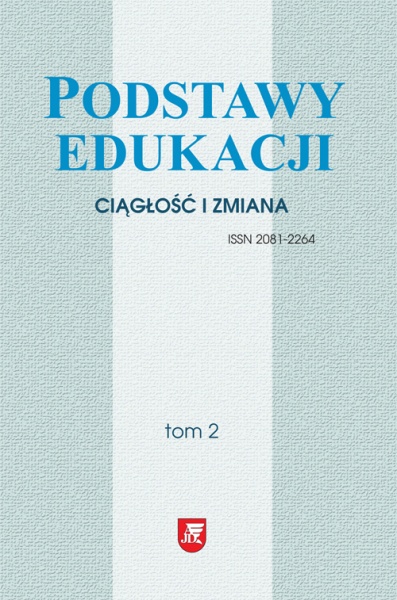Abstract
The work introduced under the title: Visual Analogies in Education. At the Basis of Anthropological Idea of Students’ Training (M. Muszyńska, 2005) has theoreticalempirical character and belongs to the domain of aesthetical education. The visual analogies are the main subject of study. Capability of their apprehension in art is, probably, the origin of developing interpretation qualifi cations, the potential serving for future intertextual practices. Theoretical analyses (G. Bachelard, J. Derrida, M. Heidegger, M. Eliade, C. G. Jung, I. Kant, J. Lacan, A. Melberg, S. Kierkegaard, S. Žižek) and quality data obtained from experimental studies in the form of analogy profiles, allowed to express the following general statement: Analogy – its creating by an artist and observing the indicative relations between creations by the recipient, is the phenomenon repeatable in time (repetitive - temporal), in which renewal of meaning (idea) as well as changing „position” of the subject being in motion has a chance to occur. Analogy as metaphorical comparison is then a figure changing in time by cause not only of transformation of artistic practice, but the figure of „repetition”, which the subject wants to notice consciously and in reflection enlighten the difference as renewing the meaning. Whereas opportunities for conceptualization of analogy outline when individual perception will be projected as abductive inferential-interpretative process, in which iconic-index symbols will be recognized.
References
Bachelard, G. (1988). Poetyka marzenia. L. Brogowski (tłum.). Gdańsk.
Biela, A. (1981). Psychologiczne podstawy wnioskowania przez analogię. Warszawa.
Buczyńska-Garewicz, H. (1994). Semiotyka Peirce’a. Warszawa.
Buczyńska-Garewicz, H. (1997). Interpretacje interpretacji: semiotyka a dekonstrukcja. Toruński Przegląd Filozoficzny, 1.
Eco, U. (1996). Nieobecna struktura. A. Weinsberg (tłum.). Warszawa.
Csikszentmihalyi, M., Rochberg-Halton, E. (2002). The Meaning of Things. Domestic Symbols and the Self. Cambridge.
Dailey, A., Martindale, C., Borkum, J. (1997). Creativity, Synesthesia, and Physiognomic Perception. Creativity Research Journal, 10.
Derrida, J. (1997). Głos i fenomen. Wprowadzenie do problematyki znaku w fenomenologii Husserla. B. Banasiak (tłum.). Warszawa.
Derrida, J. (2003). Prawda w malarstwie. M. Kwietniewska (tłum.). Gdańsk.
Domino, G. (1989). Synesthesia and Creativity in Fine Arts Students: An Empirical Look. Creativity Research Journal, 2.
Dybel, P. (2000). Urwane ścieżki. Przybyszewski – Freud – Lacan. Kraków.
Fichte, J. G. (1996). Teoria wiedzy. Wybór pism. T. I. M. Siemek (tłum.). Warszawa.
Gardner, H. (1988). Creativity: An Interdyscyplinarny Perspective. Creativity Research Journal, 1.
Gardner, H. (2002). Inteligencje wielorakie. Teoria w praktyce. A. Jankowski (tłum.). Poznań.
Grant, M. A. (1988). The Wisdom of Merlan. W: P. O’Callaghan (red.). A Clashing of Symbols. Method and Meaning in Liberal Studiem. Washington.
Heidegger, M. (1994). Bycie i czas. B. Baran (tłum.). Warszawa.
Jung, C. G. (2002). Man and His Symbols. Carl G. Jung and M.-L. Von Franz, Joseph L. Henderson, Jolande Jacobi, Aniela Jaffé. New York, London, Toronto, Sydney, Auckland.
Kalaga, W. (2001). Mgławice dyskursu. Podmiot, tekst, interpretacja. Kraków.
Kierkegaard, S. (1992). Powtórzenie. Próba psychologii eksperymentalnej przez Constantina Constantinusa. B. Świderski (tłum.). Warszawa.
Kierkegaard, S. (2000). Pojęcie lęku. Proste rozważania o charakterze psychologicznym odniesione do dogmatycznego problemu grzechu pierworodnego autorstwa Vigiliusa Haufniensisa. A. Szwed (tłum.). Kęty.
Komendziński, T. (1996). Znak i jego ciągłość. Semiotyka C. S. Peirce’ między percepcją a recepcją. Toruń.
Lorenc, I. (2001). Świadomość i obraz. Studia z filozofii przedstawienia. Warszawa.
Matczak, A., Jaworowska, A., Stańczak, J. (2000). Rysunkowy test twórczego myślenia K. K. Urbana i H. G. Jellena. Warszawa.
Melberg, A. (2002). Teorie mimesis. Repetycja. J. Balbierz (tłum.). Kraków.
Merleau-Ponty, M. (2001). Fenomenologia percepcji. M. Kowalska, J. Migasiński (tłum.). Warszawa.
Migasiński, J. (1995). Merleau-Ponty. S. Cichowicz, M. Kowalska, J. Migasiński i in. (tłum.). Warszawa.
Nosal, C. S. (2002). Jung jako prekursor gorącego i zimnego przetwarzania informacji, Albo albo. Problemy psychologii i kultury, 1, Czucie. Warszawa.
Nycz, R. (2000). Tekstowy świat, Poststrukturalizm a wiedza o literaturze. Kraków.
Stafford, B. A. (1999). Visual Analogy. Consciousness as the Art of Connecting. London.
Tweney, R. D. (1996). Presymbolic Process in Scientific Creativity. Creativity Research Journal, 9.
Wilkoszewska, K. (1999). Filozofia amerykańska w Ameryce. Oczami outsidera. W: T. Komendziński, A. Szahaj (red.). Filozofia amerykańska dziś. Toruń.
Żegleń, U. (2000). Wprowadzenie do semiotyki teoretycznej i do semiotyki kultury. Toruń.
Žižek, S. (2001a). Przekleństwo fantazji. A. Chmielewski (tłum.). Wrocław.
Žižek, S. (2001b). Wzniosły obiekt ideologii. J. Dybel, P. Dybel (tłum.). Wrocław.
I am aware that the journal is published under the Creative Commons Attribution License (https://creativecommons.org/licenses/by/4.0/legalcode).
By submitting an article, I agree to make it available under this license.
